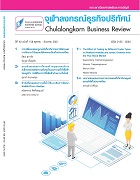The Effect of Trading by Different Trader Types on Realized Volatility and Jumps: Evidence from the Thai Stock Market
Main Article Content
Abstract
We examine the effect that different trade measures for each investor type have on realized volatility and the components of volatility. By following Barndorff-Nielsen and Shephard (2004)’s techniques, the realized volatility is decomposed into the continuous and jump components. Using a detailed high-frequency data set during 1999-2009, we find that retail investors dominate trading on the Stock Exchange of Thailand and retail trades has the greatest effect on realized volatility, and the components of realized volatility. While the increase in trading by retail investors is associated with an increase in realized volatility, their withdrawal from the market is associated with jumps in volatility. Moreover, we find the number of trades by retail investors among others have the greatest association with the continuous component of volatility suggesting their trading is associated with the release of expected news on the market. This result may suggest that some of retail traders are likely to be informed.
Article Details
Opinions and discussions in papers published by the Creative Business and Sustainability Journal (CBSJ) are deemed as personal opinions and the responsibility of the writers. They are not the opinions or responsibility of the Chulalongkorn Business School of Chulalongkorn University.
Papers, content, information etc. appearing in the Journal are deemed to be the copyright property of the Chulalongkorn Business School of Chulalongkorn University. Anybody or any organization that wishes to publish any part of them or use them in any way must obtain written permission from the Chulalongkorn Business School, Chulalongkorn University.


